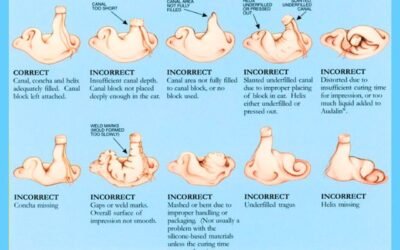Screening for Central Auditory Processing Disorder (CAPD): CAP screening assesses the possibility of existence of a CAPD and, in turn, can lead to possible referral for a comprehensive CAPD evaluation. Psychologists and speech-language pathologists are two professional groups that would likely screen for CAP on a routine basis. For CAPD screening there are many Questionnaires and Screening Tests are available.
Questionnaires for CAPD
Questionnaires are a common tool for ascertaining the likelihood that an individual exhibits functional behavioral limitations in his/her communication, language, and learning. The following is a description of some of the CAP Questionnaires available:
Fisher Auditory Problems Checklist (Fisher, 1985)
- This was the first developed CAP screening questionnaire, with normative data available from kindergarten to grade 6.
- It has been designed to rate 25 items of concern. Many of the items listed on this questionnaire are commonly used in other CAPD profiles.
Children’s Auditory Processing Performance Scale (CHAPPS) (Smoski et al., 1992)
- There are six listening situations (ideal, quiet, attention, memory, noise, and multiple inputs), and the rater (parent or teacher) compares the student to children of similar age and background.
- There are a total of 36 questions, and the choices vary from +1 (less difficulty than others) to −5 (cannot function in the situation). Scores can range from +36 to −180, and the more negative the score, the more difficulty that is noted.
- A child who receives a total score of −12 to −180 is at risk for CAPD.
Screening Instrument for Targeting Educational Risk (SIFTER) (Anderson, 1989)
- There are 15 questions over five category areas: Communication, academics, attention, class participation, and social behavior.
- Scoring consists of 15 points per category, resulting in a failure if one is rated at or below 6 or 7 (depending on the category).
Buffalo Model Questionnaire—Revised (BMQ-R) (Katz and Zalweski, 2013)
- The questionnaire contains 39 questions dealing with CAPD including categories/subcategories: Decoding, Noise, Memory, Various TFM, Integration, Organization, and General (more than one category).
- Data are provided for three age groups (<6, 6 to 18, >18) with 122 controls and 213 who have CAPD.
- The characteristics that were most common were for Decoding (understands oral directions) and Memory (remembers oral directions), both of which had 79% hit rates in the CAPD group.
- BMQ-R is useful prior to the evaluation, following the evaluation to compare with the test findings, before therapy, and independently validating the progress in therapy.
Screening Tests CAPD
Screening test performance scores have sometimes been used to label a child with CAPD, rather than to refer the child for further testing (Jerger and Musiek, 2000) by an audiologist to rule in or out the diagnosis of CAPD. The following is a description of some of the CAP screening tests available:
The Screening Test for Auditory Processing Disorders (SCAN) (Keith, 1986)
- For ages 5 to 12 years the SCAN-3 for Children: Tests for Auditory Processing Disorders (SCAN-3:C) (Keith, 2009b).
- For ages 13 to 50 years, the SCAN-3 for Adolescents and Adults: Tests for Auditory Processing Disorders (SCAN 3:A) (Keith, 2009a) are used.
- Both SCAN protocols contain three screening measures (Gap Detection, Auditory Figure-Ground, Competing Words), four diagnostic tests (Filtered Words, Auditory FigureGround, Competing Words, Competing Sentences), and three supplementary tests (Auditory Figure-Ground at +12 dB SNR and at 0 dB SNR, Time-Compressed Sentences).
The Differential Screening Test for Processing (DSTP) (Richard and Ferre, 2006)
It was developed to differentiate skills associated with three neurologic levels of processing that are integrated depending on the communication task:
- Perception of primary acoustic characteristics of auditory signals
- Identification of acoustic aspects related to the phonemic portion of language
- The ability to attribute meaning to language.
The Auditory Skills Assessment (ASA) (Geffner and Goldman, 2010)
It is the first tool developed to assess the skills of young children (3.6 to 6.11 years) as CAPD weaknesses, most certainly, influence language and academic skills.
The ASA consists of six subtests:
- Speech discrimination in noise (+6 dB SNR)
- Mimicry (repeat a nonsense word)
- Blending (morphemes or phonemes are given first with a visual cue followed with no visual cue)
- Rhyming awareness
- Tonal discrimination (ability to distinguish same or different musical instrument notes)
- Tonal patterning (points to the picture of a piano or an oboe to indicate which sound was heard last)
The Test of Auditory Perceptual Skills—Revised (TAPS-R; Gardner, 1996)
- Bellis (2003) indicates that the TAPS-R may be an instrument that can provide some indication of auditory perceptual ability, but it does not indicate the specific underlying auditory processing difficulties.
- Keller et al. (2006) found a correlation with test performance on digit span (Wechsler, 1991) and CAPD. This indicates that psychologists should refer individuals for a CAPD evaluation when a client shows weakness on tests sensitive to short-term auditory memory span.
References:
⇒ Handbook of Clinical Audiology – JACK KATZ, Ph.D. (Book)
⇒ Handbook of Central Auditory Processing Disorder Volume I (Auditory Neuroscience and Diagnosis) – Frank E. Musiek, Gail D. Chermak (Book)
You are reading about:
Screening for Central Auditory Processing Disorder (CAPD)




0 Comments